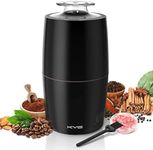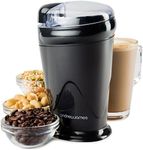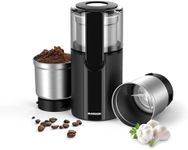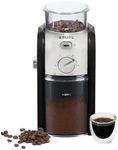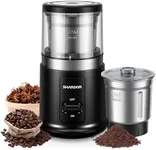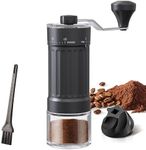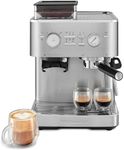Buying Guide for the Best Coffee Grinders
Choosing the right coffee grinder is essential for brewing the perfect cup of coffee. The grinder you select can significantly impact the flavor and aroma of your coffee, as it determines the consistency and size of the coffee grounds. When selecting a coffee grinder, consider your brewing method, the amount of coffee you typically make, and your taste preferences. Understanding the key specifications will help you make an informed decision that suits your coffee-making needs.Grind Size SettingsGrind size settings refer to the range of coarseness or fineness that a grinder can produce. This is important because different brewing methods require different grind sizes. For example, espresso requires a fine grind, while French press needs a coarse grind. Grinders with multiple settings offer more flexibility, allowing you to experiment with different brewing methods. If you enjoy a variety of coffee styles, choose a grinder with a wide range of settings. If you stick to one method, a grinder with fewer settings may suffice.
Burr vs. BladeThe type of grinder mechanism is crucial, with burr and blade being the two main types. Burr grinders use two revolving abrasive surfaces to crush the coffee beans, providing a more consistent grind size, which is essential for balanced flavor extraction. Blade grinders, on the other hand, use a spinning blade to chop the beans, which can result in uneven grind sizes. If you are serious about coffee and want consistent results, a burr grinder is the better choice. Blade grinders are more affordable and suitable for less precise brewing methods.
Grind CapacityGrind capacity refers to the amount of coffee beans a grinder can process at one time. This is important if you regularly brew large quantities of coffee or if you prefer to grind beans in advance. Grinders with larger capacities are ideal for households with multiple coffee drinkers or for those who entertain guests frequently. If you typically make coffee for one or two people, a grinder with a smaller capacity will be sufficient and may take up less counter space.
Material and Build QualityThe material and build quality of a coffee grinder affect its durability and performance. Grinders made from high-quality materials like stainless steel or ceramic tend to last longer and perform better over time. They are also less likely to impart any unwanted flavors to your coffee. Consider how often you will use the grinder and whether you need a robust model that can withstand frequent use. If you plan to use it daily, investing in a well-built grinder is advisable.
Ease of CleaningEase of cleaning is an important factor because coffee grinders can accumulate oils and residues that affect the taste of your coffee. A grinder that is easy to disassemble and clean will save you time and effort. Look for models with removable parts or those that come with cleaning tools. If you are someone who values convenience and hygiene, prioritize a grinder that is straightforward to clean.
Noise LevelNoise level is a consideration if you are sensitive to sound or if you live with others who might be disturbed by a loud grinder. Burr grinders tend to be quieter than blade grinders, but there are variations within each type. If you often make coffee early in the morning or late at night, you might prefer a quieter model. Consider your household's noise tolerance and choose a grinder that aligns with your environment.
